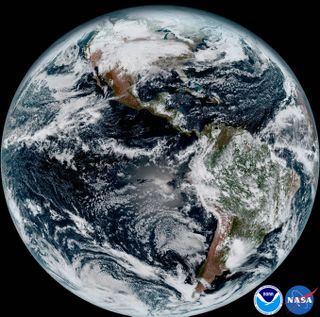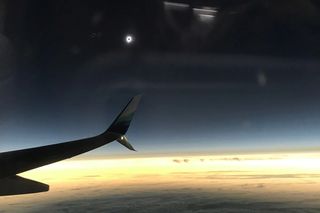NASA astronauts and weather satellites will watch next week’s solar eclipse from space.
SpaceX Crew-8 astronauts on the International Space Station (ISS), alongside at least one of the two Russian Soyuz crews on board right now, will experience a “very unique vantage point” when a total solar eclipse sweeps across Mexico, the United States and Canada on April 8, a senior NASA manager said during a livestreamed eclipse science briefing on March 26.
“Instead of looking up at the moon casting the shadow, they’ll also be able to see the shadow racing across the Earth,” said Pam Melroy, NASA deputy administrator and former astronaut, in the briefing. “So, there is involvement, and they will be able to participate in that way.”
The current ISS track suggests the astronauts will have three chances to watch the eclipse, NASA said in a follow-up release: they’ll see the shadow cast by a partial eclipse above the Pacific Ocean, a partial above California and Idaho, and perhaps totality over Maine and New Brunswick at 3:30 p.m. EDT (1930 GMT.) Satellites will also have a good view of the unique event, the agency said.
Related: Why ISS astronauts won’t know where to look for next total solar eclipse for a while
Total solar eclipses happen when the moon completely blocks the sun from Earth‘s perspective. Luckily, you don’t need to be in space to see the event. As long as you’re in the right geographical location on our planet and the skies are clear, you can see the highly anticipated event. You can find out how to do so safely in our sun-observing guide.
ISS astronauts won’t be the only ones watching the eclipse from orbit. Two satellites in the Geostationary Operational Environmental Satellites (GOES) series, which is jointly operated by NASA and the National Oceanic and Atmospheric Administration (NOAA), will use ultraviolet imagers to gaze at the sun, officials said in the March 26 briefing. The imagers on GOES-16 and GOES-18 will capture the moon’s disk passing in front of the sun, while advanced baseline imagers on the satellites will track the moon’s shadow.
Two other satellites are scheduled to launch to space post-eclipse for even more solar observations: NOAA’s GOES-U will fly no earlier than June 25 this year to examine the corona, or outer atmosphere of the sun. Also, NOAA’s Space Weather Follow On L1 (SWFO-L1) will fly a million miles from Earth in 2025 to Lagrange Point 1, a gravitationally stable point in space. There, the satellite will examine space weather, or the effect the sun’s activity has on our planet.

Expedition 71 astronauts on the ISS will be witness to the rare event in space. That group includes Crew-8 and the long-duration astronauts set to come home this fall on Soyuz MS-25. (A short-duration Soyuz crew is in space now, but is expected to return home before eclipse day.)
The astronauts on board the ISS are well trained in taking pictures of dynamic events, but the challenge is their orbit, Crew-8 NASA astronaut Michael Barratt told Space.com on Jan. 25 during a pre-launch telephone interview from NASA’s Johnson Space Center.
Since the ISS needs to boost its orbit periodically to avoid falling back into Earth’s atmosphere, and may need a last-minute shift to avoid space debris, the astronauts won’t have their exact location until close to April 8, he said.
“Every once a while, we have to tweak the orbit of our station to avoid hitting stuff,” Barratt said. “The closer we get [to April], the more we’ll be able to sharpen our approach. We’ll know what our viewing angle is going to be.”

Barratt did point out one advantage for ISS observations: Compared to the last total solar eclipse that swept across the U.S. in 2017, the camera technology is improved. He didn’t see that eclipse from space, but he did have a unique vantage point on board an Alaska Airlines charter flight observing it at 40,000 feet (12,200 meters).
“The shadow was just speeding, hurtling towards the mainland. It was really amazing to me,” he recalled of the 2017 eclipse in the Space.com interview.
RELATED STORIES:
The ISS is jointly co-managed by NASA and Roscosmos, the Russian federal space agency. Expedition 71 mission specialist Alexander Grebenki, a cosmonaut who’s part of Crew-8, told Space.com on Jan. 25 that he hadn’t received specifics yet on eclipse observations.
“I didn’t really train specifically for the observing,” Grebenkin said, speaking in Russian through an English interpreter. “I do know that it’s going to happen, and I am planning to do my best to take pictures and also observe the event itself.”
If you’re looking to observe the solar eclipse on Earth, we have you covered. Our guide on how to observe the sun safely guide tells you what you need to know to look at the sun. We also have a guide to solar eclipse glasses, and how to safely photograph the sun if you’d like to get practicing before the big day.



